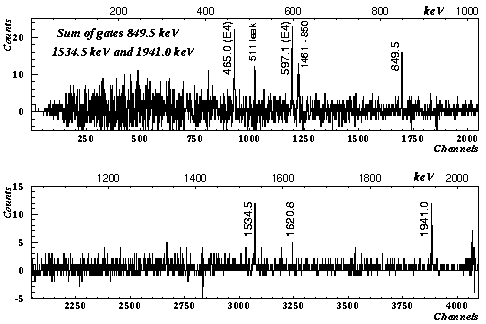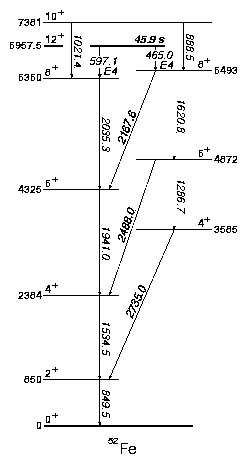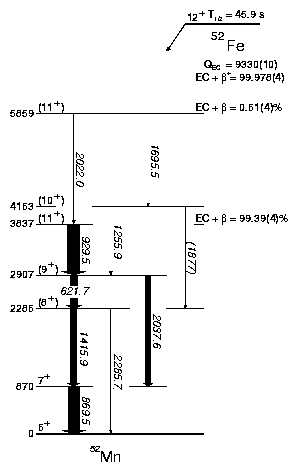| Gamma and Beta Decay of the 12+ Yrast Trap in 52Fe E, G | ||||||
|---|---|---|---|---|---|---|
| A. Gadea,1,2 S.M. Lenzi3, D.R. Napoli1, C.A. Ur4, G. Martínez-Pinedo5, M. Górska6, M. Axiotis1, G. de Angelis1, F. Brandolini3, D. Cano-Ott2, E. Farnea2, E. Nácher2,6, B. Rubio2, J. L. Tain2, R. Borcea6, J. Döring6, H. Grawe6, Z. Janas6,7, R. Kirchner6, M. La Commara6, C. Mazzocchi6,8, E. Roeckl6, K. Schmidt6, C. Fahlander9, M. Hellström9, L. Batist10, A. Plochocki7, J. Zylicz7, C. Plettner, R. Schwengner | ||||||
|
The spectroscopy of 1f7/2-shell nuclei provides a good test for shell-model calculations and the associated effective interactions. Recent advances in experimental techniques [1,2] have enabled detailed in-beam studies of high-spin states in many of the N » Z nuclei in the 1f7/2 shell, and a similarly impressive progress has been made in large-scale shell-model (LSSM) calculations [3,4]. The high-spin spectrum of 52Fe (N = Z = 26) represents a particular experimental challenge due to the presence of a 12+ isomer which acts as a ``trap'' for the de-exciting g-ray flux. In a recent work [5] performed with the g-ray detector array GASP, the level scheme of 52Fe has been extended up to the 10+ state lying above the yrast 12+ isomer. In the present report, preliminary results on the g and b decays of the 12+ state are presented. The experiment was performed at the GSI on-line mass separator, where a 2.5 mg/cm2 thick natSi target was bombarded by a 209 MeV 36Ar beam. The mass 52 secondary beam was implanted in a tape which moved away every 80 s. The implantation position was viewed by a plastic scintillator with a b-detection efficiency of 85%, two composite germanium detectors of the Cluster and Clover type, and a 60% single germanium crystal. The absolute efficiency of the germanium detectors was 3.9% for a g-ray energy of 1332 keV, which improves the detection sensitivity limit by a factor of 100 compared to that achieved in the previous study [6].

Fig. 1 Spectrum gated on the main transitions in 52Fe and in anti-coincidence with the b-counter. Events with b-g-g and g-g coincidences were recorded and afterwards sorted into 3D-cubes and 2D-matrices. The analysis of the g-g coincidences, including the ``add-back'' of the composite detectors and a veto condition derived from the b counter (see Fig. 1), allowed us for the first time to observe the g de-excitation of the 12+ isomer to the two 8+ states via E4 transitions of 597.1 and 465.0 keV, thus giving the excitation energy of the isomer as 6957.5(4) keV (see Fig. 2). This value is significantly more accurate than the previous result deduced from b decay measurements [6] and yields better agreement with the LSSM predictions [5]. The intensities per total isomer decay have been estimated to be 1.3(4) ×10-4 for the 597.1 keV 12+® 8+1 and 0.9(3) ×10-4 for the 465.0 keV 12+® 8+2 transition. We have also observed the second 11+ state of 52Mn populated in 52Fe 12+ b-decay (see Fig. 2) with an apparent feeding of 0.5%, which is in good agreement with the theoretical value of 0.3% predicted by the LSSM calculation.
Fig. 2 g-decay (left) and b-decay (right) level schemes.
1 LNL-INFN, Legnaro, Italy
|

